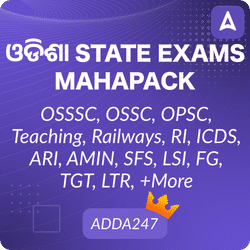General Science forms a crucial part of various competitive exams, including the OSSSC LSI (Livestock Inspector) and Forester FG (Forest Guard) exams. Here, we present a curated list of 30 multiple-choice questions (MCQs) in General Science, covering diverse topics from physics, chemistry, biology, and environmental science. These questions are designed to test your understanding and application of scientific principles, making them suitable for candidates preparing for these examinations.
Top 30 General Science MCQs for OSSSC LSI, Forester, FG
- Which of the following laws is associated with the heating effect of electric current?
a) Joule’s law
b) Ohm’s law
c) Faraday’s law
d) Newton’s law
Answer: a) Joule’s law - The value of acceleration due to gravity ‘g’ depends on:
a) Constant of Gravitation ‘G’
b) Mass of the earth ‘M’
c) Mass of the falling object ‘m’
d) Radius of the earth ‘R’
Answer: a) Constant of Gravitation ‘G’, b) Mass of the earth ‘M’, d) Radius of the earth ‘R’ - Which element in the periodic table forms the maximum number of compounds?
a) H
b) O
c) S
d) C
Answer: d) C
Explanation: Carbon forms the maximum number of compounds in the periodic table due to its tetra valency and catenation properties, allowing it to form a wide range of compounds. Allotropes of carbon, such as graphite and diamond, exhibit different properties. - A body at rest can have?
a) Speed
b) Velocity
c) Momentum
d) Energy
Answer: b) Velocity
Explanation: A body at rest can possess velocity, indicating its potential for motion. Additionally, it stores potential energy. - How much work is done in moving a charge of 5 C across two points having a potential difference of 16 V?
a) 65 J
b) 45 J
c) 40 J
d) 80 J
Answer: d) 80 J
Explanation: Work done (W) = Charge (q) × Potential difference (V) = 5 C × 16 V = 80 J - Which of the following statements is true?
a) Carbon monoxide diffuses from lungs into blood and oxygen diffuses from blood into lungs
b) Carbon dioxide diffuses from lungs into blood and oxygen diffuses from blood into lungs
c) Oxygen diffuses from lungs into blood and carbon dioxide diffuses from blood into lungs
d) Oxygen diffuses from lungs into blood and carbon monoxide diffuses from blood into lungs
Answer: c) Oxygen diffuses from lungs into blood and carbon dioxide diffuses from blood into lungs - Mendeleev could not assign a correct position to which of the following elements in his table?
a) Lithium
b) Potassium
c) Hydrogen
d) Helium
Answer: c) Hydrogen
Explanation: Mendeleev struggled to justify the position of hydrogen in his periodic table, placing it above both alkali metals and halogens due to its unique properties. - The atmospheric pressure at sea level is …….. atm?
a) 0.001
b) 1
c) 0
d) 0.1
Answer: b) 1
Explanation: The atmospheric pressure at sea level is standardized as 1 atm. - Who demonstrated that objects of different masses would reach the ground together when dropped from the same height?
a) Isaac Newton
b) Archimedes
c) Robert Boyle
d) Galileo Galilei
Answer: d) Galileo Galilei
Explanation: Galileo Galilei’s experiments showed that in the absence of air resistance, objects of different masses would fall to the ground simultaneously when dropped from the same height. - Mendeleev could not assign a correct position to which of the following elements in his table?
a) Lithium
b) Potassium
c) Hydrogen
d) Helium
Answer: c) Hydrogen
Explanation:
The position of hydrogen was not justified in Mendeleev’s periodic table. He positioned hydrogen in the first column above alkali metals. Hydrogen resembles not only alkali metals but also halogens in several ways. Hence, hydrogen can also be placed above the halogen group. - Who demonstrated that objects of different masses would reach the ground together when dropped from the same height?
a) Isaac Newton
b) Archimedes
c) Robert Boyle
d) Galileo Galilei
Answer: d) Galileo Galilei
Explanation:
According to Galileo Galilei, if objects of different masses are dropped from the same height in the absence of air resistance, the bodies will ground together at the same time. - Which of the following can neither be created nor be destroyed?
a) Force
b) Power
c) Momentum
d) Energy
Answer: d) Energy
Explanation:
The first law of thermodynamics, also known as the Law of Conservation of Energy, states that energy can neither be created nor destroyed; energy can only be transferred or changed from one form to another. - Mass / Volume = …………..?
a) Pressure
b) Area
c) Density
d) Force
Answer: c) Density
Explanation:
The density of a substance is its mass per unit volume. - A mixture of sand and salt can be separated by?
a) Sublimation
b) Sieving
c) Dissolving salt in water and then filtration
d) Dissolving salt in water and then distillation
Answer: d) Dissolving salt in water and then distillation
Explanation:
We can dissolve salt in water and then distill the water to boil away and collect salt from there. Hence, we can separate sand and salt by dissolving salt in water and then distillation. - Which of the following has low density and low melting point?
a) Na
b) Fe
c) Cu
d) Au
Answer: a) Na
Explanation:
Sodium (Na) exhibits low density and low melting point compared to the other options. It has a relatively low atomic mass and forms a soft, silvery-white metallic element. - If the electronic configuration of an element is 2, 8, 2, to which period of the Modern Periodic Table does it belong?
a) 4
b) 2
c) 12
d) 3
Answer: d) 3
Explanation:
An element with the electronic configuration 2, 8, 2 belongs to the 3rd period of the Modern Periodic Table. The period number indicates the highest energy level (shell) containing electrons. - 1 joule / second = ?
a) 1 ohm
b) 1 ampere
c) 1 watt
d) 1 coulomb
Answer: c) 1 watt
Explanation:
One joule per second is equivalent to one watt. Watt is the unit of power, defined as the rate of energy transfer or conversion per unit time. - Modern periodic table is based on…?
a) atomic number
b) number of positrons
c) atomic mass number
d) number of neutrons
Answer: a) atomic number
Explanation:
The modern periodic table is based on the periodic law, stating that the chemical properties of elements are a periodic function of their atomic number. - A boy, of mass 50 kg, runs up a staircase of 45 steps in 10 s. If the height of each step is 14 cm, find his power. Take g = 10 m/s²?
a) 315 m/s
b) 315 W
c) 337.5 W
d) 310.55 J
Answer: b) 315 W
Explanation:
Given: mass (m) = 50 kg, height (h) = 630 cm = 6.30 m, time (t) = 10 s, acceleration due to gravity (g) = 10 m/s². Potential Energy (PE) = mgh = 3150 J. Power = PE/time = 315 W. - Which of the following can undergo sublimation?
A) Ammonium chloride
B) Ammonium chlorate
C) Ammonium sulphate
D) Ammonium phosphate
Answer: A) Ammonium chloride
Explanation: Ammonium chloride can undergo sublimation, transitioning from a solid to a gas when heated. - An object of mass 13 kg is moving with a uniform velocity of 5 m/s. What is the kinetic energy possessed by the object?
A) 187.5 J
B) 17.5 J
C) 162.5 J
D) 162.5 m/s
Answer: C) 162.5 J - The property of metals wherein they can be beaten into thin sheets is called?
A) Expansion
B) Malleability
C) Ductility
D) Conduction
Answer: B) Malleability
Explanation: Malleability refers to the ability of metals to be beaten into thin sheets. - The esophagus and lining of the mouth are also covered with…?
A) Squamous epithelium
B) Ciliated epithelium
C) Columnar epithelium
D) Glandular epithelium
Answer: A) Squamous epithelium
Explanation: Both the esophagus and the lining of the mouth are covered with squamous epithelium. - The millions period consists of the places?
A) M, TH, HM
B) O, T, M
C) M, TM
D) TTh, HTh, M
Answer: A) M, TH, HM
Explanation: The millions period consists of the places: Million, Hundred Millions, Thousand Millions. - The pH of pure water is?
A) 2
B) 6
C) 7
D) 8
Answer: C) 7
Explanation: Pure water has a pH of 7, indicating neutrality. - Which of the following is not a Connective Tissue?
A) Cartilage tissue
B) Muscular Tissue
C) Adipose Tissue
D) Ligament
Answer: B) Muscular Tissue
Explanation: Muscular tissue is not a connective tissue; it’s specialized tissue responsible for applying forces through contraction. - The walls of sclerenchyma cells are thickened due to ____?
A) Pectin
B) Hemi-cellulose
C) Cellulose
D) Lignin
Answer: D) Lignin
Explanation: Sclerenchyma cell walls are thickened due to lignin, providing strength and rigidity. - What is the ability of a metal to be drawn into thin wires called?
A) Ductility
B) Sonorous
C) Malleability
D) Intractability
Answer: A) Ductility
Explanation: Ductility refers to the ability of metals to be drawn into thin wires. - The organs that have different basic structure (or different basic design) but have similar appearance and perform similar functions are called?
A) Biogenetic law
B) Analogous organs
C) Homologous organs
D) Fossils
Answer: B) Analogous organs
Explanation: Analogous organs have different origins but perform similar functions and have similar appearances. - What is the power of an electric bulb with a voltage of 240V and a current of 0.6A?
a) 40W
b) 400W
c) 144W
d) 14.4W
Answer: c) 144W
Explanation:
The power (P) can be calculated using the formula:
P=V*I
P=240*0.6
P=144W





